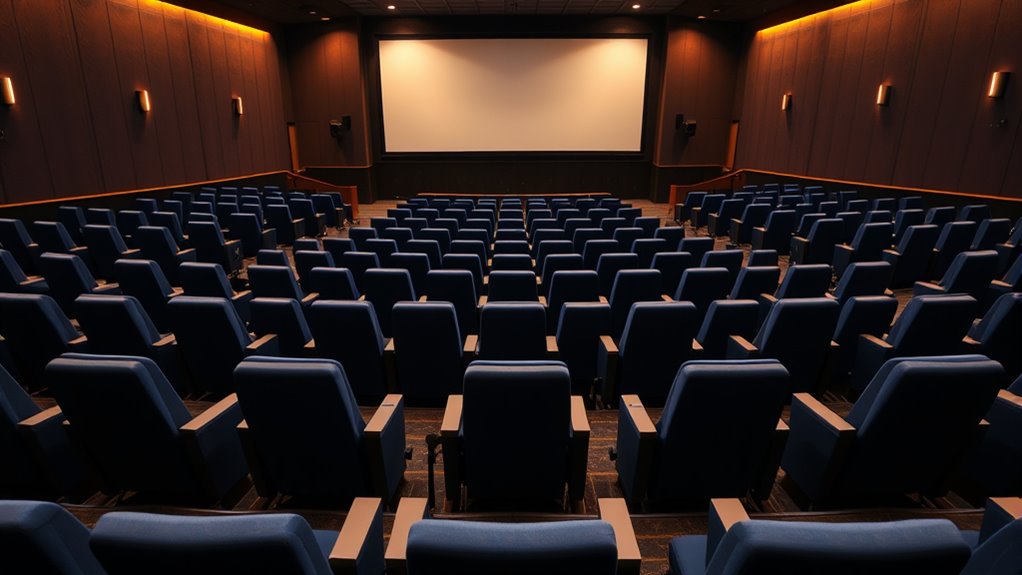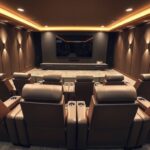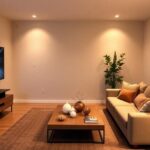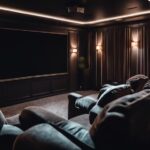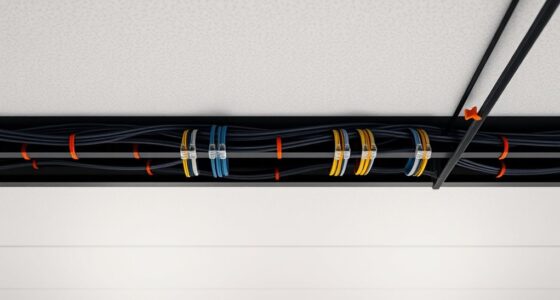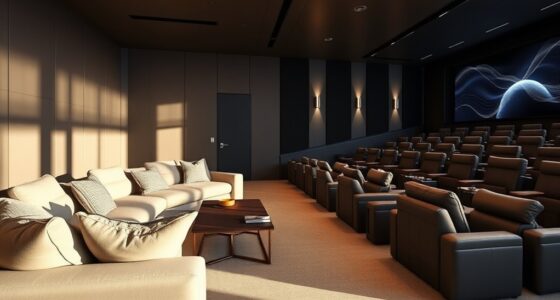For ideal viewing, choose a seating layout that promotes engagement and accessibility. Use tiered or stadium-style arrangements indoors to guarantee clear sightlines for everyone, while outdoor venues benefit from staggered setups to avoid obstructions. Prioritize comfortable seats, wide pathways, and accessible spaces for all guests. An effective design balances interaction, comfort, and visibility, making every attendee feel connected. Keep exploring to discover more tips on creating the perfect seating plan for your event.
Key Takeaways
- Use tiered or stadium-style seating to ensure unobstructed sightlines for all viewers.
- Arrange seats in a semi-circular or angled layout to foster engagement and focus on the main stage or screen.
- Incorporate staggered seating outdoors to prevent terrain obstructions and improve visual clarity.
- Prioritize comfortable seating with clear sightlines and good acoustics to enhance overall viewing experience.
- Allocate accessible seating with unobstructed views, ensuring inclusivity and better engagement for all attendees.

Choosing the right seating layout can considerably enhance your viewing experience, whether you’re setting up a home theater, conference room, or outdoor event. The way you arrange seats directly impacts how well your audience engages with the content and how accessible the setup is for everyone. To maximize engagement, you want to create a layout that encourages interaction and keeps everyone focused on the main screen or stage. This means avoiding long rows that leave some viewers disengaged or feeling disconnected from the action. Instead, consider semi-circular or tiered arrangements that bring the audience closer and foster a sense of connection. These configurations help viewers feel more involved, making it easier to maintain their attention and enjoy the event fully.
Optimal seating layouts boost engagement and accessibility, fostering connection and keeping everyone focused on the main event.
Accessibility considerations should also be at the forefront of your planning. You need to ensure that your seating accommodates guests with mobility challenges or other special needs. This might involve reserving spaces with extra room for wheelchairs or providing accessible seats with appropriate armrests and clear sightlines. It’s essential to position these seats where they won’t be obstructed and where they can easily see and hear what’s happening. Not only does this demonstrate inclusivity, but it also enhances overall audience engagement by making everyone feel valued and comfortable. When designing your layout, think about the pathways and ensure they are wide enough for easy navigation, especially for those with mobility aids. Also, consider the sightlines — seats should be arranged so that everyone has a clear view of the screen or stage without obstruction, regardless of physical ability.
Another key factor is ensuring that your seating plan promotes good acoustics and sightlines. For indoor spaces, tiered or stadium-style seating often works well, as it prevents heads from blocking views and helps distribute sound evenly. For outdoor setups, staggered seating or multiple tiers can prevent visual and auditory obstructions caused by terrain or other obstacles. When arranging seats, keep in mind that engagement isn’t just about proximity; it’s also about comfort and clarity. Comfortable seating encourages longer attention spans, and clear sightlines ensure that every audience member feels connected to the event. Additionally, utilizing audience feedback can help refine your layout for optimal engagement and comfort.
Ultimately, your goal is to create a seating layout that balances engagement with accessibility. Thoughtful planning will result in a more enjoyable, inclusive experience for everyone in the audience. When people feel comfortable, involved, and able to see and hear well, they’re more likely to stay engaged and have a positive experience. This careful approach ensures your event runs smoothly and leaves a lasting impression on all attendees.
Frequently Asked Questions
How Does Lighting Affect Seating Arrangements for Optimal Viewing?
Lighting design plays a vital role in shaping your seating arrangements for ideal viewing. When you plan your space, consider how lighting impacts sightline optimization—avoid glare or shadows that could hinder your view. Position seats where lighting complements the sightline, ensuring that ambient or task lighting enhances visibility without causing distractions. Proper lighting and thoughtful seating layout work together to create an environment where everyone enjoys clear, unobstructed views.
What Materials Are Best for Comfortable, Long-Term Seating?
Perfectly plush pillows and durable fabrics define the best materials for comfortable, long-term seating. You’ll want cushions that provide cushion comfort, supporting you comfortably through hours of viewing. Opt for sturdy, breathable fabrics like leather, microfiber, or high-quality polyester, which withstand wear and tear. These materials guarantee your seats stay stylish and sturdy, offering lasting comfort and durability, so you can relax and enjoy without worry.
How Can Seating Be Customized for Different Event Types?
You can customize seating for different event types by adjusting layout and flexibility to boost audience engagement and optimize space utilization. For conferences, opt for theater-style seating to maximize capacity. In workshops or banquets, arrange tables and chairs to encourage interaction. Use movable furniture to easily reconfigure spaces, making certain the setup suits the event’s goals. This approach ensures your seating layout enhances engagement while making the best use of available space.
Are There Ergonomic Considerations for Audience Health?
Did you know that poor seating ergonomics can cause discomfort and long-term health issues? You should prioritize audience posture by choosing chairs that support the lower back and promote good alignment. Incorporate ergonomic considerations into your seating layout to guarantee comfort and reduce fatigue. When designing your space, think about adjustable features and spacing, so your audience stays comfortable and engaged, making your event a healthier experience for everyone.
How to Incorporate Accessibility Into Seating Layouts?
You should incorporate accessibility into your seating layouts by ensuring inclusive design principles are followed. Include designated spaces for assistive technology like wheelchairs and hearing devices, and make sure pathways are wide enough for easy navigation. Position seats to provide clear sightlines for everyone, and consider adjustable seating options. By prioritizing inclusive design, you create an environment where all audience members feel welcomed and accommodated comfortably.
Conclusion
By arranging your seats thoughtfully, you can maximize everyone’s viewing experience. Did you know that the ideal viewing angle for screens is within 30 degrees? This means positioning seats to stay within that range can dramatically improve comfort and clarity. So, take a moment to plan your seating layout carefully—you’ll enjoy better visuals and a more enjoyable experience, whether watching a movie or giving a presentation. Small adjustments can make a big difference in how you see and feel.
